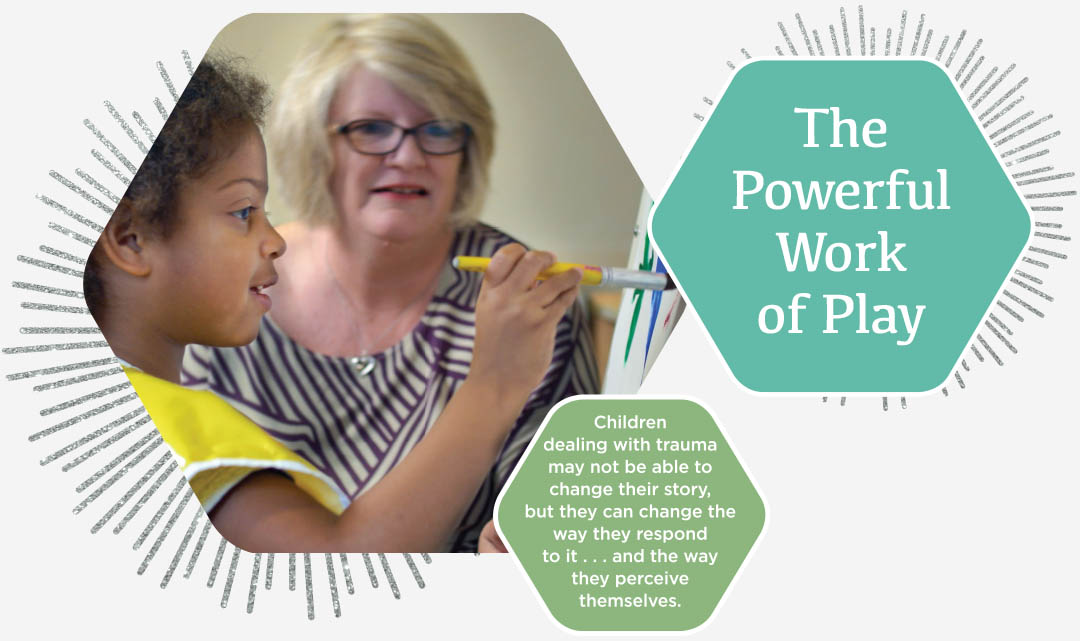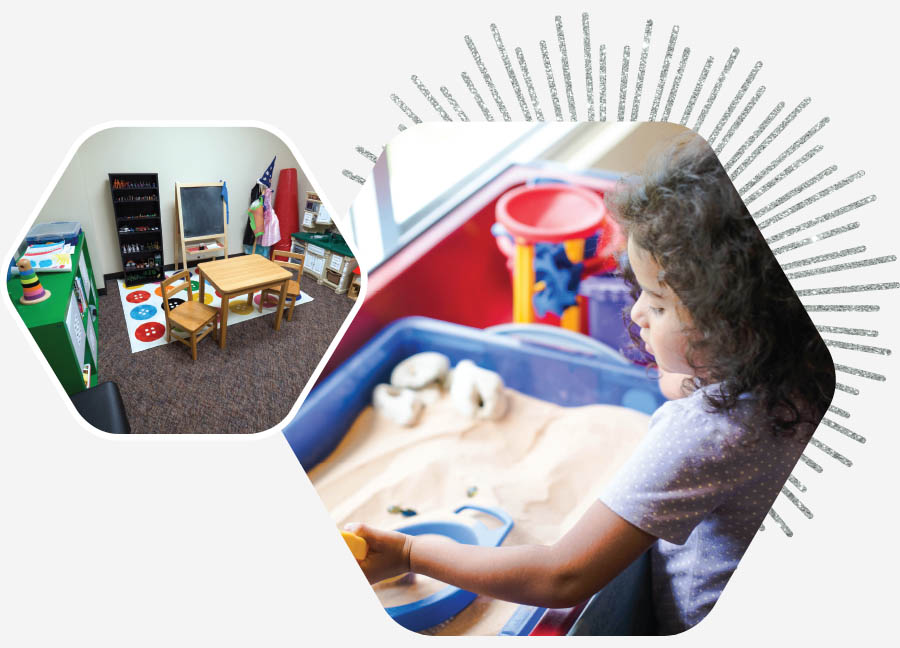The Powerful Work of Play

The first time I came to the play therapy playroom, it was kind of hard to believe. The shelves were stuffed with every kind of toy I could imagine! Cars and trucks, games and crafts, tons of animal and people figures, play guns and swords, dolls, dollhouses, and things to build with. And there were other fun things…like dress-up clothes, an art easel, puppets, a BIG bop bag, and even a small sandbox! The lady my mom told me would help me said I could play with anything in the room in any way I wanted!
But…I didn’t know what I wanted to do, or what to say. So I just sat at the little table in the middle of the room and looked around. It was quiet for a long time. I liked the quiet, and the lady seemed okay with it too. She just smiled, and she didn’t even ask me a bunch of questions or tell me what to do! Finally, I built a sandcastle in the sandbox and put a few special things by my castle. And when it was time to leave, I didn’t want to go. – A young child’s reflections
For young children dealing with trauma, the play therapy room quickly becomes a safe spot. Yet much more than “child’s play” takes place as the children interact with trained therapists who understand the importance of play.
According to the Association for Play Therapy, the natural process of play helps children regulate emotions and improve communication and problem-solving skills. Play also lifts a child’s spirit and self-esteem.
“Play is a child’s language, and toys are their words,” said Lorena Mendez, Regional Director-Corpus Christi for STCH Ministries Family Counseling, quoting a common axiom among play therapists. “There’s no better way to establish a connection with a child than to say, ‘Hey, let’s play.’ Play therapy gives a child the freedom to express their experiences, needs, wants, wishes, and feelings in a way that is developmentally appropriate for them.”
 Mendez, a licensed professional counselor-supervisor (LPC-S) and registered play therapist-supervisor (RPT-S), divides her time between counseling, sharing her expertise through conferences, and overseeing the work of other STCH Ministries therapists, including those working toward their registered play therapist (RPT) certification.
Mendez, a licensed professional counselor-supervisor (LPC-S) and registered play therapist-supervisor (RPT-S), divides her time between counseling, sharing her expertise through conferences, and overseeing the work of other STCH Ministries therapists, including those working toward their registered play therapist (RPT) certification.
Parents typically bring their children to STCH Ministries for counseling because of behavioral issues at home or school. Changes in behavior can arise in situations of bullying, divorce or abandonment, past physical or sexual abuse, and grief over the loss of a parent. Depression, attention deficit/hyperactivity disorder (ADHD), and conduct disorders also create difficulties for children and their families.
“Trauma is very disruptive and makes everyone feel out of control,” shared STCH Ministries therapist Carolyn Cocklin, who is currently working toward her RPT. “Emotionally speaking, children have some of the same feelings and thinking as adults who experience post-traumatic stress – anger, confusion, fear, guilt, or shame. However, children lack the reasoning abilities to understand the why behind a trauma, or the cognitive ability to express in words what they are experiencing. So, they typically blame themselves. It is important to give children a place where they can feel validated and in control. The play therapy playroom becomes the child’s little world where they can mentally process things and begin to stabilize their behavior.”
STCH Ministries therapists are trained in various play therapy methods to meet the unique challenges of each child. Often, they choose the non-directive client-centered approach to best build rapport, trust, and consistency, Mendez said.
During a client-centered session, the play therapist patiently listens and observes the child at play without judgment. The therapist does not ask questions about what the child is doing or question them about their past. To give the child greater creative freedom, the therapist also avoids labeling any object or behavior. If a child asks the therapist for help with decisions or actions, the therapist will return responsibility to the child with gentle, empowering phrases such as: “You choose”; “That can be anything you want it to be”; or an encouraging “You can do it.”
Therapists see parents privately every three or four weeks during the play therapy counseling process. Therapists work hard to give parents positive feedback on their child to help them see the child as a whole person and not just the problem. As adults in a child’s world become healthier emotionally, and family dynamics improve, children get better too.
“What I love about play therapy is how unique it is,” Mendez said. “It is unlike anything the child will experience in life because it is so non-directive. Kids get plenty of teaching, instructions, discipline, and criticism in the big world. The small play therapy room gives children the opportunity to get what they need without anyone telling them what that is. It’s a chance to learn who they are and how they would do it if given the time and space.”
Children will be kept safe, of course, and are not allowed to hurt themselves, the therapist, or any property. But limits are not set until there is a need for a boundary based on a child’s behavior. When children do test the boundaries with their behavior, the therapist will show empathy first, then verbalize a limit and gently redirect the child.
Important work takes place in the playroom when children use toys as symbols to represent something in their life. Therapists call this a play metaphor.
 “Many times children are unaware they are using metaphor in their play,” Mendez explained. “They will use the metaphor to express feelings, to show what they want to happen, or to work through a painful memory, fear, or experience. A vital part of our connection with kids in the playroom is to stay in the metaphor with them.”
“Many times children are unaware they are using metaphor in their play,” Mendez explained. “They will use the metaphor to express feelings, to show what they want to happen, or to work through a painful memory, fear, or experience. A vital part of our connection with kids in the playroom is to stay in the metaphor with them.”
Cocklin also finds this to be true. “A child’s metaphorical play provides a picture of how the child perceives themselves and their life,” Cocklin said.
“As they live out events of their past in the playroom, the metaphor is ‘live’ and it can be controlled. The child can even rewrite the ending for what is happening in their life. This is how they get a big win!”
It is important to realize that play therapy is not a quick fix for children. It helps stabilize the child at the developmental stage they are at, as well as provide the child with a greater ability to perceive, respond to, and manage their lives and behaviors in a healthier way. It helps them regain some control over their lives. But the effects of trauma may need to be addressed again in the future as the child reaches a new level of development.
Over the course of the treatment, parents gradually begin noticing their child seems “better,” has fewer tantrums, or doesn’t get in trouble as much. Children move from being sad, angry, or fearful in the playroom to being more spontaneous, content, and confident. Therapists also see improvements in the areas of problem-solving, communication, self-care, and self-control.
“The world is God’s playroom,” Mendez concluded. “He allows us time, space, and energy to get what we need or what we think we need. Just like the therapist in the play therapy room, He sits WITH us as we learn from the boundaries He has set, and His unconditional, loving presence. It takes a while, but He is patient—watching, waiting, validating, hoping, and believing the best for our lives. This is the love we take into the playroom each time we enter a child’s world.”
To find out if play therapy is right for your child, contact STCH Ministries Family Counseling at 1.833.83.STCHM.













